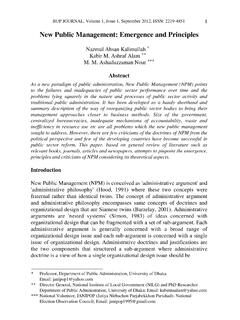Transcription of Origin and theoretical basis of New Public Management
1 International Public Management Journal 4 (2001) 1 25. Origin and theoretical basis of New Public Management Gernod Gruening*. Arbeitsbereich Public Management , Hochschule fuer Wirtschaft und Politik, Hamburg, Germany Abstract The article describes the characteristics of New Public Management (NPM) and gives a cursory overview of the development of the behavioral-administrative sciences and their relation to NPM. A. descriptive model of the behavioral-administrative sciences is developed that pits three internally consistent scientific worldviews that are incommensurable to each other. From this, the theoretical origins of NPM can be traced to a variety of theoretical perspectives. Although the special mix of characteristics of NPM is new, it does not represent a paradigm change. Indeed, it is improbable that there will ever be one paradigm for the behavioral administrative sciences; and without an accepted paradigm, a paradigm change is not really possible. 2001 Elsevier Science Inc.
2 All rights reserved. 1. Introduction From where does New Public Management (NPM) come? The conventional wisdom holds that NPM has its origins in Public -choice theory and managerialism (Aucoin, 1990, pp. 115; Dunsire, 1995, pp. 21 29; Lueder, 1996, pp. 93; Naschold et al., 1995, pp. 1 8;. Reichard, 1996, p. 245f; Schedler, 1995, p. 155). Does this formula fit, and is it exhaustive? Moreover, is NPM really new? Finally, does NPM represent a paradigm change, as some writers claim (Aucoin, 1995, p. 3; Borins, 1994, p. 2; Kamensky, 1996, p. 250; OECD, 1995, pp. 8, 25; Osborne and Gaebler, 1993, p. 321; Reinermann, 1995, p. 6)? To answer these questions, I describe the development of administrative thought in the , the home of Public -choice theory and managerialism. I focus on the because it dominates theoretical developments in the behavioral-administrative sciences, owing in part to the sheer size of its academic establishment, its diversity, and the richness of its approaches.
3 On the presumption that the attempts of practitioners, consultants, and scientists * Tel.: 49-040-4329-0676; fax: 49-040-4329-0469. E-mail address: (G. Gruening). 1096-7494/01/$ see front matter 2001 Elsevier Science Inc. All rights reserved. PII: S 1 0 9 6 - 7 4 9 4 ( 0 1 ) 0 0 0 4 1 - 1. 2 G. Gruening / International Public Management Journal 4 (2001) 1 25. Table 1. Characteristics of the New Public Management Undisputed characteristics (identified by most Debatable attributes (identified by some, but not all, observers) observers). Budget cuts Legal, budget, and spending constraints Vouchers Rationalization of jurisdictions Accountability for performance Policy analysis and evaluation Performance auditing Improved regulation Privatization Rationalization or streamlining of administrative structures Customers (one-stop shops, case Management ) Democratization and citizen participation Decentralization Strategic planning and Management Separation of provision and production Competition Performance measurement Changed Management style Contracting out Freedom to manage (flexibility).
4 Improved accounting Personnel Management (incentives). User charges Separation of politics and administration Improved financial Management More use of information technology to reform administrative organizations and delivery systems are influenced by their disci- plinary socialization and training, this survey will examine whether theoretical concepts other than Public choice and managerialism have influenced NPM. 2. Characteristics of New Public Management The NPM movement began in the late 1970s and early 1980s. Its first practitioners emerged in the United Kingdom under Prime Minister Margaret Thatcher and in the municipal governments in the ( , Sunnyvale, California) that had suffered most heavily from economic recession and tax revolts. Next, the governments of New Zealand and Australia joined the movement. Their successes put NPM administrative reforms on the agendas of most OECD countries and other nations as well (OECD, 1995). Only later did academics identify the common characteristics of these reforms and organize them under the label of New Public Management (Dunsire, 1995, p.)
5 21). These common attributes of NPM undisputed characteristics that are almost always mentioned by academic observers are listed in Table 1, along with a few debatable attributes that are included by some but not all observers (see, for example, Borins, 1994, 1995; Boston, Martin, Pallott, & Walsh, 1996; Buschor, 1994; Gore, 1994; Hood, 1991; Nashold et al., 1995; Reichard, 1992; and Stewart and Walsh, 1992). G. Gruening / International Public Management Journal 4 (2001) 1 25 3. 3. The development of administrative thought in the United States The conscious study of Public administration in the began in a time when its Public administration was in a state of disrepute. In the late 19th century, the administrative mechanisms in the were dominated by the spoils system administrative positions were distributed to those who contributed to the victorious party's electoral success. Administra- tive personnel, therefore, changed frequently. Incompetence, inefficiency, and corruption were common (Weber, 1956, p.
6 839ff; Van Riper, 1987; Stone and Stone, 1975; Schachter, 1989). In reaction to this corruption, the Progressives created a movement to reform politics and administration , pressing for a more interventionist state, the separation of politics and administration , the merit principle (tenured, neutral, and competent administrators), and sound financial Management . The Progressives achieved several notable successes: a career civil service (Pendleton Act, 1883), line-item budgets, and less political partisanship and corruption (Eisenach, 1994; Lee, 1995; Waldo, 1948). Classical Public administration In the Progressive movement, the New York Bureau for Municipal Research was a key player. Influenced by Frederick Taylor's scientific Management , the New York Bureau believed that efficiency was the best solution to the problem of corruption and incompetence. These progressive reformers imported techniques and studies from scientific Management ( , on efficient street paving and snow removal).
7 They were the first to use performance indicators to benchmark the efficiency of Public organizations, one purpose of which was to identify corruption (Schachter, 1989). In the 1920s, some practitioners and academics created the science of Public administration on the fundamentals of the progressive reform successes particularly the presupposition of loyal bureaucrats, honest politicians, and the politics - administration dichotomy . These reformers the new scientists of Public adminis - tration built a theory of organization that they supplemented with the concept of manage- ment. These principles were: Y The principle of division of work and specialization. Y The principle of homogeneity. Y The principle of unity of command. Y The principle of hierarchy with respect to the delegation of authority. Y The principle of accountability. Y The principle of span of control. Y The staff principle (Gulick, 1937; Urwick, 1937; Mooney, 1937; Graicunas, 1937). The reformers expected Public managers, working within organizational structures built on these principles, to perform the following functions: Planning, Organizing, Staffing, Directing, Coordinating, Reporting and Budgeting or, in Luther Gulick's shorthand: POS- DCORB (Gulick, 1937, p.)
8 13). The reformers also advocated reorganization to streamline 4 G. Gruening / International Public Management Journal 4 (2001) 1 25. and consolidate organizations and to standardize administrative procedures (Lee, 1995;. Henry, 1975; Arnold, 1995). During the New Deal of the 1930s, the scope of government activity and the Public administration of the was dramatically expanded but still guided by the principles of Public administration . The New Deal followed (and realized) the societal vision of the progressives. Government in the became more involved: it regulated more activities; it followed social-democratic ideals; it seemed to be built on scientific objectivity; and it promised material freedom (Egger, 1975; Waldo, 1948; Van Riper, 1987). I call this cluster of organization and Management concepts and the closely related ethos of orderly government an active state, and label the belief in objective knowledge that serves to control the social and physical environment classical Public administration .
9 Neoclassical Public administration After World War II, academics began to reassess and question the principles of classical Public administration . One of the most rigorous critics was Herbert Simon, whose work set the tone and direction for neoclassic Public administration . His dissertation, with the title Administrative Behavior: A Study of Decision-Making in Administrative Organization, contained the buzzwords of the era: behavior, decisions, and organization. Simon said that the principles of administration are not scientific, but inconsistent prov- erbs that were drawn from common sense (Simon, 1976). He suggested founding Public administration on rigorous and scientific observation and on (inductively) derived laws of human behavior. He advocated separating facts from value judgments and dividing science into pure and applied branches (Simon, 1976; Simon, Smithburg, & Thompson, 1962). From this perspective, objective scientific knowledge serves to control the social environment.
10 Simon's ideas significantly influenced a host of scholars who undertook studies of behavior and decisions in administrative organizations and created a new, more precise vocabulary and research methodology. This neoclassical Public administration (and Simon himself) followed the common trends of behaviorism, structural functionalism, and systems theory, and employed the theoretical underpinnings of welfare economics and decision theory. Nevertheless, during this time, governmental reformers continued to follow the Progres- sives' ideals and classical theory: organizations and jurisdictions were streamlined and consolidated; executive power was strengthened and unified. Still, the main practical event of this period was the invention of the Program, Planning, and Budgeting System, or PPBS (Waldo, 1969). PPBS was based on microeconomic decision techniques and a strong belief that central planning of the national administration (and economy) could lead to successful optimization.


